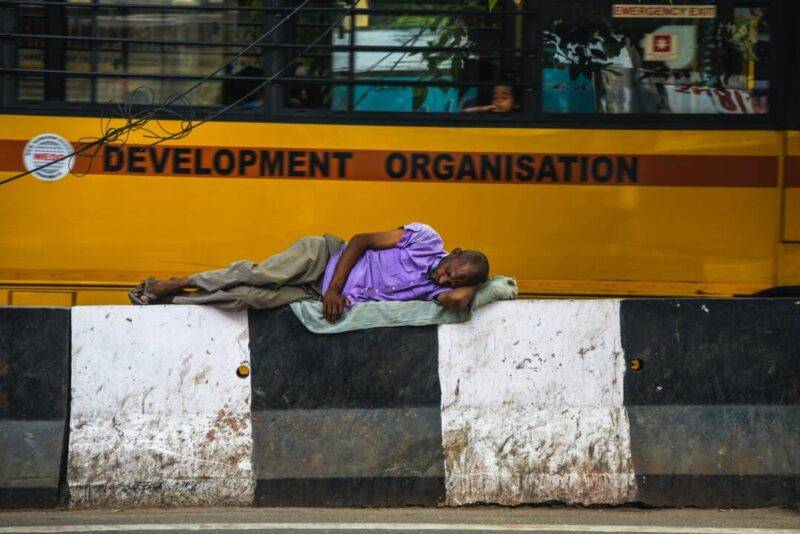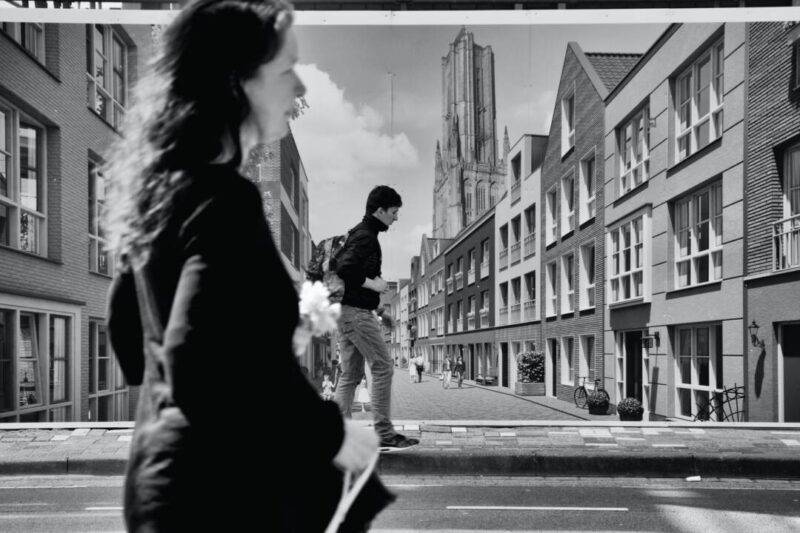Last Updated on July 21, 2021 by PixelPluck
What is street photography? You don’t need a dictionary to define it. Henri Cartier-Bresson, Andre Kertesz, David Seymour (Chim), Robert Doisneau, Willy Ronis, Brassai, Walker Evans, Elliott Erwitt, Mark Riboud, Garry Winogrand, Helen Levitt, and Robert Frank are the masters of Street Photography. You’ll have a much better understanding for what street photography when you see their work.
A picture of a person on a street is no more street photography than a picture of a street is street photography. A good street photograph is a story, though the story may be confusing or even one you’ll never be able to decipher. There must be interesting human behavior in the picture. Something beyond a simple shot of a person or people, no matter how weird the people are, no matter how much they fit stereotypes, no matter how briskly they walk, no matter how they slouch against the stoop. Often there’s an element of mystery in the story, and unless the picture makes you think, it’s not much of a street photograph.
There are many different genres of Photography. Street photography gets confused with photojournalism because, in a sense, both are documentary photography.
Professional Tips for Street Photography
- Take risks, take difficult photos, take many photos.
- Think before you take portraits.
- Know your light, know your camera, know your focal length.
- See the photo before you raise your camera.
- Seek or create clean backgrounds.
- Look 3 meters and further away, anticipate with your feet.
- Shoot what is interesting irrespective of the place.
- Don’t get in each other’s photos. Don’t take the same photo as someone else.
- If you find a good spot, wait. Be patient.
- Shoot head-on. Don’t be scared.
Street Photography Explained
Street photography is not just about photographing people on the street. It is an art. Use street photography to tell a story which the eyes overlook. There is always a story everywhere waiting to be told. Use your creative vision.

Street Photography is an Attitude
More than anything Street Photography is an attitude, it is an openness to being amazed by what comes your way, it is unlearning the habit of categorizing and dismissing every day as being ‘just every day and beginning to recognize that extraordinary, beautiful, and subtle stories are occurring in front of you every day of your life if you can see them. I think you can be a Street Photographer without a camera and without making photographs, it is just the more insecure Street Photographers like myself that have to record and show off their ability to ‘see’.
How many other forms of photography essentially have ‘wonder’ at their heart? That’s what makes Street Photography almost a spiritual process for many because it is so personal and so akin to a kind of photographic enlightenment. Street Photography helps me understand the nature of my society and my place in it, I do it more for myself than I do for an external audience and like Buddhist enlightenment, I do achieve happiness through gaining that understanding. I have certainly experienced ‘Matrix’ like moments of revelation when in a public place when I see things, moments just reveal themselves because I have put myself in the right situation for it to happen.
Replacing your own Head
If you must take a camera onto the streets then a high degree of dexterity will be required to ‘see’ things and at the same time coordinate the device to make a visual record. Simplicity is the key, keep your equipment small, quiet and uncomplicated. You need one body and one lens, you won’t have time for zooming so prime lenses are best and you are more invisible closer with a short lens than you are further away with a long lens.
I advise sleeping with your camera, carry it everywhere, know its weight and its feel in your hand, know how to hold it easily and steadily with one hand, learn how far back your lens places you from a subject on the pavement, learn how much depth of field you get at each f stop, decide how much noise is acceptable to you and shoot close to its iso threshold, get a feel for its slight shutter delay, know how far the lens barrel turns from the near to the far side of the pavement. Make this camera so much part of you that even thinking of buying a new one would be akin to replacing your head.

In the early days, don’t set out to make a certain kind of picture, just make lots of pictures for weeks or months and pull out the ones that strike you as special even if you can’t initially identify why. As time passes and you are patient, passionate, and dedicated you will be able to lay these striking images out together and if you are lucky you will see your natural vision emerge and you can call yourself a Street Photographer and perhaps an artist. The last thing you should do is to try to make pictures like Bruce Gilden (just don’t) or try to make pictures like Alex Webb or Cartier Bresson or Matt Stuart. As soon as you adopt other strategies in the street you start to blinker your natural vision ever so slightly and that would be a shame.
Street Photography is primarily a spiritual and intellectual activity, it takes great awareness, mental presence, self-confidence, and faith, it’s like courting large bull… the exposing of a photograph at the end is just the last blunt physical act that completes the process, it is a mistake to apply too much weight to that last part.
As a Street Photographer, you are different, you are not like the others, you are an oddity both in society and in photography. In society, you are odd because you are just standing there looking whilst everyone rushes past to their next shopping experience or intake of salty, sugary, fatty food. In photography, you are odd because your motivation is not financial and you don’t go to photo trade shows unless it’s to people watch. You are not part of either world, it can be lonely not talking about equipment and bags and not oiling the wheels of retail…. if it weren’t for online street photography forums you could feel isolated like some lonely eccentric.
Stop dismissing the everyday and realize that it is your very subject.
OK, Street Photographers are not the Jedi Knights of photography but as you spend more and more time on the streets watching and shooting you do develop an instinct for what is about to happen or where you should probably be standing which can lead to a higher hit rate. If the pictures aren’t coming, try just photographing non-pictures, any busy corner, or just snapping every passer-by to get you looking and tuned in a little.
Look around for anything at all that doesn’t happen on that spot all day every day, this could be a shop refurbishment, a road sweeper working his way along with a brush, scaffolding going up, a UPS delivery, anything small that could provide a background element or develop into something unexpected.
Work one place for a long period so that you can see what happens there, the same bus with a travel advert that passes at 20 past the hour every hour, lights that stop the traffic with a nice reflection in the window from Advertising hoardings…. you must stop dismissing every day and realize that it is your very subject.
So these were the 10 awesome & useful Street Photography Tips. Also, Check out the best eBooks on Street Photography.
-h/t Nick T. & Russ Lewis